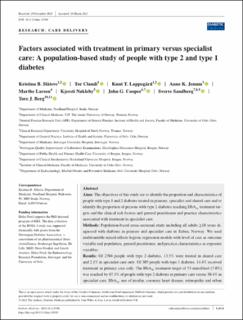| dc.contributor.author | Slåtsve, Kristina Barbara | |
| dc.contributor.author | Claudi, Tor | |
| dc.contributor.author | Lappegård, Knut Tore | |
| dc.contributor.author | Jenum, Anne Karen | |
| dc.contributor.author | Larsen, Marthe | |
| dc.contributor.author | Nøkleby, Kjersti | |
| dc.contributor.author | Cooper, John | |
| dc.contributor.author | Sandberg, Sverre | |
| dc.contributor.author | Berg, Tore Julsrud | |
| dc.date.accessioned | 2021-08-13T06:42:59Z | |
| dc.date.available | 2021-08-13T06:42:59Z | |
| dc.date.created | 2021-06-21T11:55:38Z | |
| dc.date.issued | 2021 | |
| dc.identifier.issn | 0742-3071 | |
| dc.identifier.uri | https://hdl.handle.net/11250/2767671 | |
| dc.description.abstract | Aims
The objectives of this study are to identify the proportion and characteristics of people with type 1 and 2 diabetes treated in primary, specialist and shared care and to identify the proportion of persons with type 2 diabetes reaching HbA1c treatment targets and the clinical risk factors and general practitioner and practice characteristics associated with treatment in specialist care.
Methods
Population-based cross-sectional study including all adults ≥18 years diagnosed with diabetes in primary and specialist care in Salten, Norway. We used multivariable mixed-effects logistic regression models with level of care as outcome variable and population, general practitioner, and practice characteristics as exposure variables.
Results
Of 2704 people with type 2 diabetes, 13.5% were treated in shared care and 2.1% in specialist care only. Of 305 people with type 1 diabetes, 14.4% received treatment in primary care only. The HbA1c treatment target of 53 mmol/mol (7.0%) was reached by 67.3% of people with type 2 diabetes in primary care versus 30.4% in specialist care. HbA1c, use of insulin, coronary heart disease, retinopathy and urban practice location were positively associated with treatment in specialist care. General practitioners’ use of a structured form and a diabetes nurse were negatively associated with specialist care.
Conclusions
Of people with type 2 diabetes, 16% were treated in specialist care. They had higher HbA1c and more vascular complications, as expected from priority guidelines. The use of a structured diabetes form and diabetes nurses seem to support type 2 diabetes follow-up in primary care. | en_US |
| dc.language.iso | eng | en_US |
| dc.publisher | Wiley | en_US |
| dc.rights | Attribution-NonCommercial-NoDerivatives 4.0 Internasjonal | * |
| dc.rights.uri | http://creativecommons.org/licenses/by-nc-nd/4.0/deed.no | * |
| dc.title | Factors associated with treatment in primary versus specialist care: A population-based study of people with type 2 and type 1 diabetes | en_US |
| dc.type | Journal article | en_US |
| dc.type | Peer reviewed | en_US |
| dc.description.version | publishedVersion | en_US |
| dc.rights.holder | Copyright 2021 The Authors | en_US |
| dc.source.articlenumber | e14580 | en_US |
| cristin.ispublished | true | |
| cristin.fulltext | original | |
| cristin.qualitycode | 1 | |
| dc.identifier.doi | 10.1111/dme.14580 | |
| dc.identifier.cristin | 1917213 | |
| dc.source.journal | Diabetic Medicine | en_US |
| dc.identifier.citation | Diabetic Medicine. 2021, 38 (7), e14580. | en_US |
| dc.source.volume | 38 | en_US |
| dc.source.issue | 7 | en_US |

